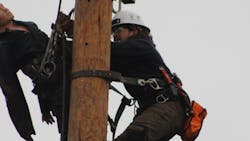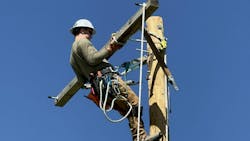Pathways to Power: Pre-Apprenticeship Programs Lighting the Way for Future Lineworkers
Key Highlights
- Pre-apprenticeship programs offer a cost-effective, hands-on pathway into the electrical utility industry, reducing time and debt associated with traditional college routes.
- Students gain practical experience working with underground and overhead systems, preparing them for apprenticeships and advanced roles like foreman or substation technician.
- Mentorship from experienced instructors and real-world training at facilities like IAMU enhances student confidence and technical skills.
- Success stories of students like Trevor Grefe and Kellen Miller illustrate the diverse backgrounds and motivations driving new entrants into the trade.
- The industry is evolving with new technologies, emphasizing brain over brawn, and creating more opportunities for aspiring lineworkers to serve their communities.
The line trade offers aspiring apprentices the ability to earn while they learn. Instead of racking up mountains of college debt, they can train for a lifelong career to power their communities. Before they embark on a four-year apprenticeship program, however, some high school graduates are breaking into line work through pre-apprenticeship programs.
For example, the Des Moines Area Community College (DMACC) offers a one-year Electric Utility Technology Program. By earning credits to apply to a formal apprenticeship, they can reduce the time achieving the journeyman-level status.
Kellen Miller, a graduate of the training program, said right now is a pivotal moment in the pre-apprentice world.
“There are so many more opportunities popping up that allow everyone to try out the trade before jumping right into a massive commitment of a career,” Miller said. “I think that this also offers students the ability to learn in an environment in which accidents can be learned from, not harmed from.”
At DMACC, the students learn how to work with underground and overhead electrical distribution systems and gain skills to install and maintain transmission systems. Throughout the program, they attend classes at the DMACC campus and complete hands-on training at the Iowa Association of Municipal Utilities (IAMU) facility in Ankeny, Iowa, and the MidAmerican Energy indoor training yard.
The following profiles shine the spotlight on two of these students: Trevor Grefe of Des Moines, Iowa, and Miller of Humbolt, Iowa. By pursuing training at DMACC, they are both prepared to dive into the world of line work once they enter an apprenticeship program.
Infusing Technology into the Classroom for Aspiring Lineworkers
As technology is changing in the line trade out in the field, it’s also evolving in the training classrooms. Today’s pre-apprentices and apprentices can practice their skills on simulators and software before they get their hands on actual equipment and machines.
“These simulators create a safe environment for students to learn how to operate certain machines without having to worry about getting hurt from the machines,” said Kellen Miller, a graduate of the DMACC training program.
For example, Vermeer has simulator rigs that allow students to learn how to operate horizontal drilling machines, and Index AR Solutions has interactive learning apps for iPads. At DMACC, the students use iPads loaded with e-books and different training apps with augmented reality capabilities from Index AR Solutions. For example, when learning about pad-mount transformers, the students could pull one up in AR and scan through the different parts. With voltage regulators, they could go through the steps on taking them in and out of service.
“The iPads really helped, and the videos and book information was good quality and up to date,” Trevor Grefe said.
The lineworkers at the local investor-owned utility, MidAmerican Energy, have been using this software for a few years now, and the students had the privilege of using the same software, Miller said.
“These iPads offered interactive learning apps and book material that offered a 3D/hands-on environment to understand things like transformer and electrical theory that helped to solidify our knowledge of the topics,” he said.
Trevor Grefe: Looking to Serve Others and Work Outdoors
The line trade often attracts those with a love for the outdoors and a passion for serving their communities. For example, Grefe said he was trying to figure out what to do with his life, and he discovered the line trade.
“Working outside and with my hands, finding the concept of electricity fascinating and being able to help people are a few reasons as to how I became interested in the line trade,” Grefe said.
In the beginning, he said one of the biggest challenges for him was the fact that he was learning a whole new trade.
“I had basically zero knowledge of the trade when I started, so it was a lot of new information in the beginning,” he said. “Once I started to learn things, the rest of the material would kind of fall in place and make sense, and then it didn’t feel so daunting. Some of my favorite things were learning three-phase theory and how things work within the utility infrastructure.”
“Working outside with my hands, finding the concept of electricity fascinating and being able to help people are a few reasons as to how I became interested in the line trade.” — Trevor Grefe
On a typical day, he spent time in the classroom reading his textbook and listening to lectures and the rest of the day outdoors.
“The activities outside ranged anywhere from learning to operate digger derricks to trenching in an underground with a mini excavator to constructing a 70-ft H transmission structure to pole-top rescue,” Grefe said.
In the future, he would like to pursue being a journeyman and eventually work up to a foreman or a higher position. He said he would also thoroughly enjoy going the substation route.
“Either route has their pros and cons,” he said. “I plan on reaching this goal by first getting an apprenticeship and completing it.”
He said he feels very fortunate to have had the opportunity to attend DMACC’s Electric Utility Technology program, train on the equipment at IAMU’s training facility and use MidAmerican’s indoor training facility during the winter. He said while a lot of the information about three-phase electricity and how things work is the same, today’s pre-apprentices are learning about new technologies and ways of accomplishing certain tasks.
“There is a lot more using your brain in today’s world versus muscling everything around like back in the day,” Grefe said.
Kellen Miller: From Architecture to Power Lines
Miller, another student at DMACC, first got interested in the line trade during high school, when he was also considering a future career in architecture. At that time, he was an intern with ETHOS Design Group, an architectural firm. At the time, the studio was working on the Missouri Valley JATC Training Facility in Indianola, Iowa.
“Because of this position at the architectural firm, I was able to receive a private tour of the facility once it was completed,” he recalled. “In the main office of the building, there was a photo of a lineman working on a transmission line while hanging out of a helicopter. That image alone was enough to encourage me to switch career paths and look into the line trade. It was something I instantly wanted to do with my life.”
When he first started in the program, he said he ran into the challenge of overthinking.
“I have a very mechanical mind and a deep understanding of the world around me as well as a motivation to understand how everything works,” Miller said. “In some moments, I would find myself focusing on details about aspects of the project that didn’t pertain to the task at hand and that weren’t important to the completion of the project. By learning how to pause and focus on what was important, it really helped me as a student to excel in a way that I didn’t at the beginning of the year.”
While in the program, Miller arrived at 6:30 a.m. and started classwork at 7 a.m. before spending a few hours inside the classroom to learn about the projects, machines and materials he would work on later in the day. The outside training varied between pulling in conductor overhead, trenching underground services or even building a substation on site.
“Every day was filled with new experiences that felt like true learning,” Miller said. “There were never moments of feeling like we were doing busy work. The content we learned about in the classroom could be directly correlated with the activities that we would do out in the field.”
He said his instructor, Don Finn, served as a personal mentor to him and the other students during the training program. He said learning from a great teacher makes a world of difference in confidence while learning.
“Don is patient, kind and knowledgeable enough to lead anyone who has a desire to learn about the trade,” he said. “He invested so much time and energy into giving us vast amounts of knowledge about the trade from so much time he worked out in the field. It’s truly been a blessing to be able to be taught by someone who doesn’t just know about the trade, but also who has lived it their entire life.”
After graduating from the program, he landed a job as an apprentice lineworker with the City of Pocahontas, Iowa. This work position gives him the best of both worlds — his desire to work long hours on projects and also the ability to be home with his family. One day, however, he hopes to get the opportunity to work on transmission lines from a helicopter.
“I want to make sure that I understand how to build electrical infrastructure from the ground so that I know what I’m doing when I get to be hundreds of feet in the air,” he said.
Three Predictions for the Future of the Line Trade
As pre-apprentices start their careers in the line trade, they will be able to test out new technologies in the field and work on projects to modernize the grid. When looking to the future, here are a few things the recent DMACC graduates forecast for the utility industry.
-
A massive updating of the infrastructure. “Currently, with all the data centers being built, it is causing some strain on an already outdated system,” said Trevor Grefe.
-
Integration of SCADA into more cooperatives. “It is fairly widespread from my understanding, but there are still some smaller rural cooperatives here in Iowa that either don’t have it or are just starting to integrate it into their system,” Kellen Miller said.
-
Increasing image analysis by AI. While this is already underway in the industry, Miller expects to see more of it in the future. For example, through Siemens Energy’s SIEAERO program, a helicopter or drone equipped with several different types of cameras and sensors can be used for detection of hot spots and corona damage. AI then scans the images taken and indicates what damage is happening and in what locations and how and when things need to be replaced. “Anywhere you can add drone use, AI, SCADA and thermal imaging, you will see saved time and increased safety,” Miller added.
About the Author
Amy Fischbach
Electric Utilities Operations
Amy Fischbach is the Field Editor for T&D World magazine and manages the Electric Utility Operations section. She is the host of the Line Life Podcast, which celebrates the grit, courage and inspirational teamwork of the line trade. She also works on the annual Lineworker Supplement and the Vegetation Management Supplement as well as the Lineman Life and Lineman's Rodeo News enewsletters. Amy also covers events such as the Trees & Utilities conference and the International Lineman's Rodeo. She is the past president of the ASBPE Educational Foundation and ASBPE and earned her bachelor's and master's degrees in journalism from Kansas State University. She can be reached at [email protected].

